High flavonoid accompanied with high starch accumulation triggered by nutrient starvation in bioenergy crop duckweed (Landoltia punctata)
- PMID: 28201992
- PMCID: PMC5310006
- DOI: 10.1186/s12864-017-3559-z
High flavonoid accompanied with high starch accumulation triggered by nutrient starvation in bioenergy crop duckweed (Landoltia punctata)
Abstract
Background: As the fastest growing plant, duckweed can thrive on anthropogenic wastewater. The purple-backed duckweed, Landoltia punctata, is rich in starch and flavonoids. However, the molecular biological basis of high flavonoid and low lignin content remains largely unknown, as does the best method to combine nutrients removed from sewage and the utilization value improvement of duckweed biomass.
Results: A combined omics study was performed to investigate the biosynthesis of flavonoid and the metabolic flux changes in L. punctata grown in different culture medium. Phenylalanine metabolism related transcripts were identified and carefully analyzed. Expression quantification results showed that most of the flavonoid biosynthetic transcripts were relatively highly expressed, while most lignin-related transcripts were poorly expressed or failed to be detected by iTRAQ based proteomic analyses. This explains why duckweed has a much lower lignin percentage and higher flavonoid content than most other plants. Growing in distilled water, expression of most flavonoid-related transcripts were increased, while most were decreased in uniconazole treated L. punctata (1/6 × Hoagland + 800 mg•L-1 uniconazole). When L. punctata was cultivated in full nutrient medium (1/6 × Hoagland), more than half of these transcripts were increased, however others were suppressed. Metabolome results showed that a total of 20 flavonoid compounds were separated by HPLC in L. punctata grown in uniconazole and full nutrient medium. The quantities of all 20 compounds were decreased by uniconazole, while 11 were increased and 6 decreased when grown in full nutrient medium. Nutrient starvation resulted in an obvious purple accumulation on the underside of each frond.
Conclusions: The high flavonoid and low lignin content of L. punctata appears to be predominantly caused by the flavonoid-directed metabolic flux. Nutrient starvation is the best option to obtain high starch and flavonoid accumulation simultaneously in a short time for biofuels fermentation and natural products isolation.
Keywords: Combined omics; Duckweed; Flavonoids; Nutrient starvation; Starch; Uniconazole.
Figures
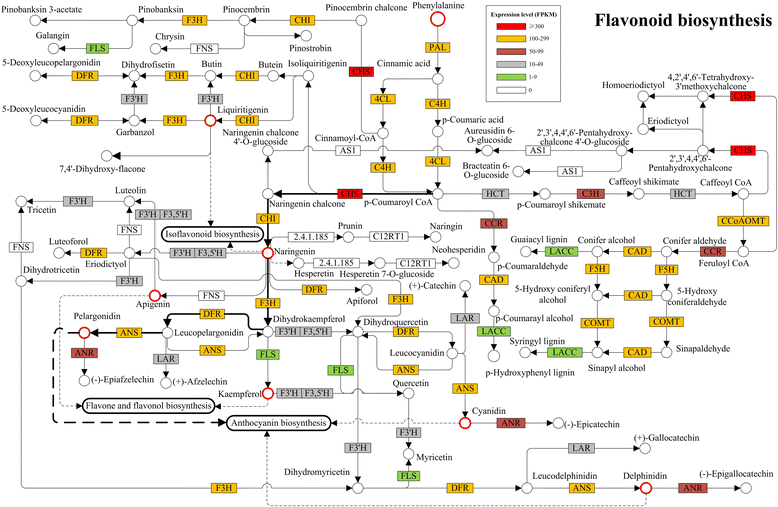

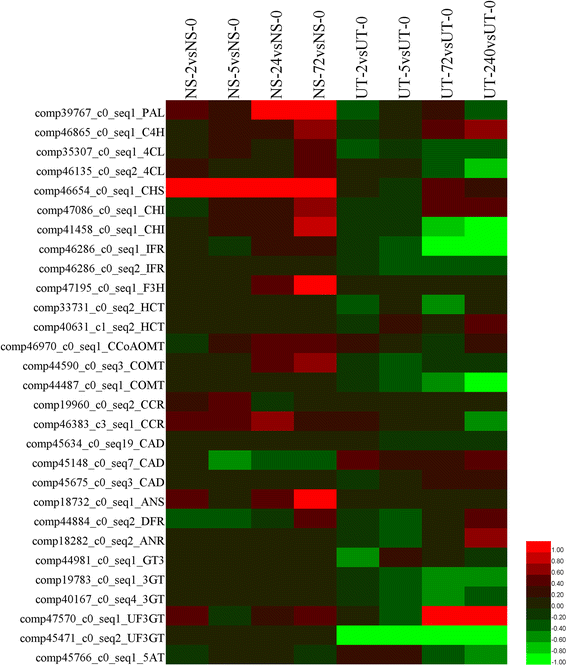
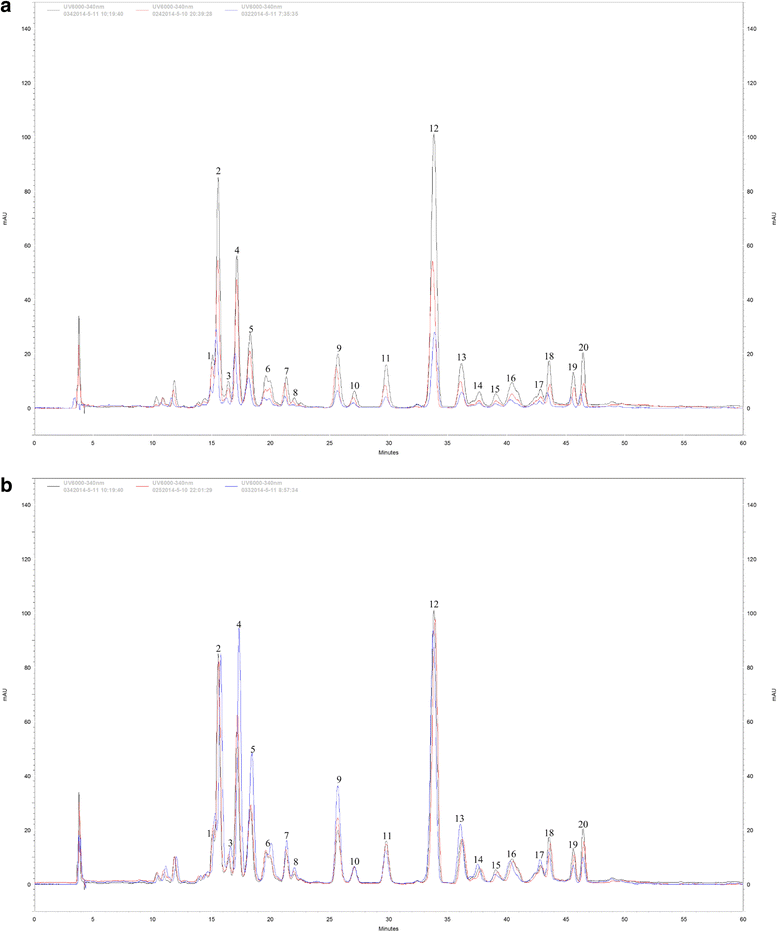
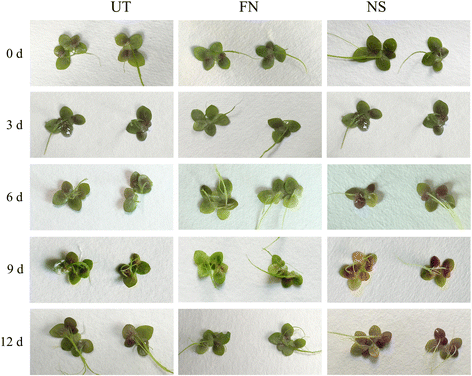
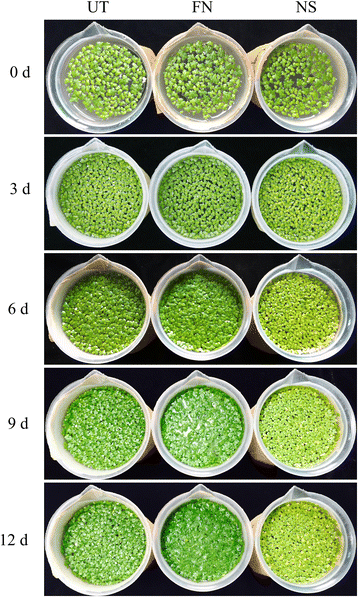
Similar articles
-
Comparative transcriptome analysis to investigate the high starch accumulation of duckweed (Landoltia punctata) under nutrient starvation.Biotechnol Biofuels. 2013 May 8;6(1):72. doi: 10.1186/1754-6834-6-72. Biotechnol Biofuels. 2013. PMID: 23651472 Free PMC article.
-
Using proteomic analysis to investigate uniconazole-induced phytohormone variation and starch accumulation in duckweed (Landoltia punctata).BMC Biotechnol. 2015 Sep 15;15:81. doi: 10.1186/s12896-015-0198-9. BMC Biotechnol. 2015. PMID: 26369558 Free PMC article.
-
Nutrient starvation and light deprivation effects on starch accumulation in Landoltia punctata cultivated on anaerobically digested dairy manure.J Environ Qual. 2020 Jul;49(4):1044-1053. doi: 10.1002/jeq2.20092. Epub 2020 Jun 3. J Environ Qual. 2020. PMID: 33016485
-
Growing duckweed for biofuel production: a review.Plant Biol (Stuttg). 2015 Jan;17 Suppl 1:16-23. doi: 10.1111/plb.12216. Epub 2014 Jul 1. Plant Biol (Stuttg). 2015. PMID: 24985498 Review.
-
Heavy metals/-metalloids (As) phytoremediation with Landoltia punctata and Lemna sp. (duckweeds): coupling with biorefinery prospects for sustainable phytotechnologies.Environ Sci Pollut Res Int. 2024 Mar;31(11):16216-16240. doi: 10.1007/s11356-024-32177-5. Epub 2024 Feb 9. Environ Sci Pollut Res Int. 2024. PMID: 38334920 Review.
Cited by
-
Decomposition of Wolffia arrhiza residues rapidly increases mineral nitrogen and decreases extractable phosphorus in acidic soils.Environ Monit Assess. 2018 Aug 10;190(9):510. doi: 10.1007/s10661-018-6895-9. Environ Monit Assess. 2018. PMID: 30097725
-
Metabolic Profiling and Transcriptome Analysis Reveal the Key Role of Flavonoids in Internode Coloration of Phyllostachys violascens cv. Viridisulcata.Front Plant Sci. 2022 Jan 28;12:788895. doi: 10.3389/fpls.2021.788895. eCollection 2021. Front Plant Sci. 2022. PMID: 35154183 Free PMC article.
-
Identification of α-Glucosidase Inhibitors from Leaf Extract of Pepper (Capsicum spp.) through Metabolomic Analysis.Metabolites. 2021 Sep 22;11(10):649. doi: 10.3390/metabo11100649. Metabolites. 2021. PMID: 34677364 Free PMC article.
-
Genomes and Transcriptomes of Duckweeds.Front Chem. 2018 Jun 20;6:230. doi: 10.3389/fchem.2018.00230. eCollection 2018. Front Chem. 2018. PMID: 29974050 Free PMC article. Review.
-
Integrated Transcriptomics and Metabolomics Analysis Reveals the Effects of Cutting on the Synthesis of Flavonoids and Saponins in Chinese Herbal Medicine Astragalus mongholious.Metabolites. 2024 Jan 30;14(2):97. doi: 10.3390/metabo14020097. Metabolites. 2024. PMID: 38392989 Free PMC article.
References
-
- Mazur WM, Duke JA, Wähälä K, Rasku S, Adlercreutz H. Isoflavonoids and lignans in legumes: nutritional and health aspects in humans. J Nutr Biochem. 1998;9(4):193–200. doi: 10.1016/S0955-2863(97)00184-8. - DOI
-
- Crowden R, Jarman S. 3-deoxyanthocyanins from the fern Blechnum procerum. Phytochemistry. 1974;13(9):1947–1948. doi: 10.1016/0031-9422(74)85122-8. - DOI
Publication types
MeSH terms
Substances
LinkOut - more resources
Full Text Sources
Other Literature Sources
Research Materials

